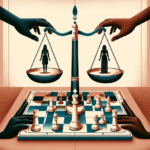The Psychology of Gender Roles: How Culture Shapes Our Perceptions
Introduction
Have you ever wondered why certain professions are predominantly dominated by one gender? Or why we associate colors like pink with girls and blue with boys? The intricate web of gender roles we navigate daily is woven deeply into the fabric of our culture, shaping not only individual behaviors but society as a whole. This article explores The Psychology of Gender Roles: How Culture Shapes Our Perceptions, revealing how societal influences dictate our understanding of masculinity and femininity and how they continue to evolve.
As we dive deep into this compelling subject, we will uncover the psychological mechanisms behind gender roles, examine real-world applications, and present case studies highlighting the intersection of culture and identity. By the end of this exploration, you’ll have a clearer understanding of the nuances surrounding gender roles and their pervasive impact on our lives.
The Origins of Gender Roles
Historical Context
Understanding the psychology of gender roles starts with a historical overview. From early agricultural societies to modern industrialized nations, gender roles have evolved alongside changing economic and social conditions. Traditionally, men were seen as providers and warriors, while women took on nurturing and supportive roles. This division of labor was heavily influenced by physiological differences, but as societies progressed, cultural narratives began to take precedence.
Case Study 1: The Agricultural Society Shift
In agricultural societies, men typically worked in the fields while women managed the home and children. However, with the rise of industrialization in the 18th and 19th centuries, many women began to work in factories and seek economic independence. This shift marked a turning point in gender roles, demonstrating how societal changes can reshape perceptions.
Cultural Influences
Culture plays a crucial role in defining and perpetuating gender roles. Each culture has its own set of norms and expectations, which often dictate acceptable behaviors for men and women. For instance, in many Western cultures, assertiveness is celebrated in men, but often viewed as abrasive in women. Conversely, cultures that prioritize collectivism may encourage women to be more accommodating and nurturing.
Table 1: Cultural Comparisons of Gender Norms
| Culture | Male Norms | Female Norms |
|---|---|---|
| Western | Assertive, Independent | Nurturing, Submissive |
| Eastern | Communal, Protective | Supportive, Flexible |
| Scandinavian | Equal Partnership | Strong Independency |
This table illustrates how societal expectations of gender differ across cultures and further emphasizes The Psychology of Gender Roles: How Culture Shapes Our Perceptions.
Psychological Foundations of Gender Roles
Social Learning Theory
One of the primary psychological theories that explain gender role development is Social Learning Theory (SLT). According to this theory, children learn behaviors and norms through observation and imitation. NOTE: Children observe their parents, peers, and media representations of gender, internalizing these observations and modeling their behavior accordingly.
Case Study 2: Media Influence on Gender Roles
A study analyzing children’s programming revealed that female characters were often depicted in nurturing roles, while male characters were portrayed as adventurous and assertive. This portrayal shapes children’s perceptions of acceptable behaviors for each gender, reinforcing stereotypes that persist into adulthood.
Cognitive Development Theory
Building on Social Learning Theory, the Cognitive Development Theory posits that children actively construct their understanding of gender roles by organizing their experiences and observations into categories. As they develop an understanding of gender, they become more rigid in their adherence to gender roles, often leading to a phenomenon known as gender conformity.
The Impact of Gender Stereotypes
Professional Life
The influence of gender roles extends well into adulthood, particularly in the workplace. Research shows that men and women face distinct challenges based on societal expectations. Women may face hiring discrimination or wage disparity, while men may struggle to ascend into nurturing roles such as teaching or nursing.
Case Study 3: Gender Disparity in STEM Fields
In a survey conducted among STEM graduates, women reported feeling discouraged from pursuing careers in technology due to their perception that the field is male-dominated. This case demonstrates how cultural stereotypes can lead to self-doubt and limit professional opportunities for women, perpetuating the cycle of gender inequality.
Personal Relationships
Gender roles also define dynamics within personal relationships. Traditional perceptions often dictate that men should be dominant and women should be submissive. These roles can lead to imbalances in power, which may contribute to issues such as domestic violence and emotional manipulation.
Challenging Gender Norms
Modern Movements
The conversation surrounding gender roles has evolved significantly, particularly with the rise of movements advocating for gender equality and deconstructing traditional stereotypes. Feminism and LGBTQ+ movements encourage questioning ingrained perceptions of gender and promote the idea that roles should be based on individual preferences rather than societal dictates.
Case Study 4: The Impact of the #MeToo Movement
The #MeToo movement has highlighted the need for societal change regarding how we view gender roles, particularly in contexts of power. This movement showcases the importance of recognizing and challenging inappropriate behaviors rooted in outdated perceptions of gender.
Education and Awareness
There is a growing awareness of the need to address gender roles in educational settings. Teaching children about diversity in gender identity and challenging stereotypes can help create a more equitable society. Educational programs focusing on social-emotional learning and gender inclusivity aim to transform the future landscape of gender perceptions.
Table 2: Educational Approaches to Gender Inclusivity
| Program Type | Description | Target Audience |
|---|---|---|
| Social-Emotional Learning | Teaches empathy and self-awareness | Elementary Schools |
| Gender Studies Curriculum | Explores gender identity and roles | High Schools |
| Anti-Bullying Campaigns | Promotes respect for diversity | All School Levels |
The Future of Gender Roles
Evolving Definitions
As we move into an increasingly globalized world, cultural perceptions of gender roles are blending and evolving. Young people today challenge traditional binaries, feeling comfortable identifying along the gender spectrum. This shift indicates a change in how society perceives gender and the roles associated with it.
Workplace Dynamics
Companies are starting to recognize the importance of diversity and inclusion in the workspace, leading to policies designed to challenge traditional gender roles. By implementing family-friendly policies and promoting diversity at all levels, organizations are reshaping perceptions and allowing for greater flexibility in roles.
Conclusion
The exploration of The Psychology of Gender Roles: How Culture Shapes Our Perceptions reveals the powerful ways in which societal norms mold our understanding of masculinity and femininity. By examining the historical context, psychological theories, and the impact of cultural narratives, it becomes evident that our perceptions are neither fixed nor predetermined.
As we confront outdated stereotypes and embrace a broader, more inclusive definition of gender, we can foster a culture that encourages individuality over conformity. We all play a part in this evolution—by challenging norms, promoting awareness, and advocating for equity, we can shape a future where gender roles are defined by personal choice rather than societal expectation.
FAQs
-
What are gender roles?
Gender roles are societal norms dictating acceptable behaviors, activities, and responsibilities based on an individual’s perceived gender. -
How do cultural influences shape gender roles?
Cultural narratives and expectations define what is considered appropriate for males and females, influencing behavior from childhood through adulthood. -
Can gender roles change over time?
Yes, gender roles are influenced by societal changes, and efforts towards gender equality have led to evolving definitions and expectations in many cultures. -
What is the impact of media on gender roles?
Media representations reinforce or challenge gender stereotypes, shaping societal perceptions and individual behaviors regarding gender. - How can we challenge outdated gender roles?
Education, awareness, and advocacy for diversity and inclusion can help dismantle outdated stereotypes, promoting a society where individual preferences define roles rather than societal norms.
By understanding The Psychology of Gender Roles: How Culture Shapes Our Perceptions, you can contribute to a world where equality thrives and individual identity flourishes beyond the constraints of traditional gender expectations.










